The Best Books on Writing
after reading a heap of craft books, here are my all-time favorites
In January of 2020, when I made the new year’s resolution to “get back into writing,” I bought every craft book I could get my hands on. I was determined to learn everything all the best writers had to tell me on the craft of writing. Over the last five years, reading obsessively, taking writing classes, and eventually enrolling in an MFA program, I have read most of the major craft books out there, and there are so many good ones. Honorable mentions go to The Writing Life by Annie Dillard, Bird by Bird by Anne Lamont, On Writing Well by William Zinsser, and The Art of Fiction by John Gardner. But the following list is not the craft books I have enjoyed or found useful, but the craft books that have stayed with me, that I return to again and again. These are the books I have read and reread, the ones I keep on my desk to refer to as I write, the ones I’ve highlighted and underlined to death, the ones I use when I am writing the lessons I share on here or teach in the classroom. These are the craft books that have changed me as a writer. I hope they can do the same for you.
Best on Writing:
A Swim in the Pond in the Rain by
If you can’t already tell from his 310,000 subscribers on Substack, George Saunders is completely brilliant. I don’t think I have ever annotated a book more than this one. In it, Saunders walks readers through seven Russian short stories page by page, analyzing the choices the authors made and why they were successful. So, not only do you get to read seven amazing stories, but each one serves as its own writing lesson. Even if you’re not a writer, I highly recommend this book as it changed how I read stories, helping me spot the deliberate authorial choices that previously had been invisible to me. If you read just one book on this list, let it be this one. I’ve kept it on my bedside table for five years, and I don’t plan on moving it any time soon.
On Writing by Stephen King
This book takes no prisoners. Stephen King is blunt—but he’s also right. He frankly explains his own journey to becoming a writer, and he doesn’t glamorize or mince words. According to him, the only way to make it as a writer is to read and write ALOT. He recommends one thousand words a day, six days a week, plus several daily hours spent reading. If you’re just getting back into writing, I would start with this book. It was the very first book on the craft of writing I read in January 2020 all those years ago, and it absolutely lit a fire under my ass. Plus, the “on writing” section provided some very helpful basic tips and tools to get me started on my writing journey.
Wonderbook by Jeff Vandermeer
This is by far the most fun—and the most practically actionable—craft book you will ever read. Check out my note to see some pictures I took of the interior spreads. This is a hefty guidebook with extremely clear, detailed explanations of anything you might need to know as a writer from how to gather inspiration, to how to revise, to how to write beginnings, middles, and ends, and much much more. Each page is masterfully illustrated with beautiful diagrams, flow-charts, and pictures, often accompanied by imaginative writing prompts. This is a great craft book for anyone, but if you are a writer of fantasy, science fiction, or speculative stories/books, then this is essential reading as it is one of the only craft books I know that speaks explicitly to genre writers with sections on world building, video game adaptions, magic systems and more.
Best on Writing Nonfiction:
Tell it Slant by Brenda Miller and Suzanne Paola
I took my first creative nonfiction workshop two years ago. I know you might not believe it because of how many darn essays I post on here, but I almost dropped out of the class. I went to my professor’s office, nearly in tears, to inform her I needed to drop the class because my life was boring and no one would ever want to read about it, and she recommended this book. It not only provided me with an essential foundation for understanding what creative nonfiction was and how to write it, but it gave me valuable tactics for mining my own life for stories. Now, I have too many ideas! This is a great place to start if you’re just getting into creative nonfiction.
Body Work by
Alexander Chee calls this book “one of the most liberating books on the subject of writing,” and I completely agree. There are craft lessons in this book, of course, like how to write better sex (and if you are writing any sex scenes I would say this book is a must-read), but the biggest draw for me in this book was Febos’s guidelines for how to write nonfiction ethically and how to free yourself from the guilt of writing about real people. This book helped me finally take the leap into personal essays and whenever I’m in murky waters about what to include or not include, I return to Febos’ “six parables of writing about other people.” Febos also makes one of the most compelling arguments I’ve read as to the importance and value of the personal essay, especially under patriarchy. Also, if you haven’t already, I highly recommend all of Febos’ other books, as she is a brilliant writer.
The Art of the Personal Essay, Edited by Phillip Lopate
The introduction to this book by Phillip Lopate is still the best piece of writing on the personal essay I have ever read. After the introduction, there are no craft lessons, just around seventy-five of the best personal essays you’ve ever read, with authors ranging from Seneca, to Montaigne, to Fitzgerald, To Woolf, and Dillard, and Didion. The essays cover topics as diverse as death, marriage, turtles, laughter, failure, and New York City. If you are someone who likes to learn via exemplars, then this is the book for you. I think this should be required reading for every substack writer publishing personal essays. And, even if you’re not a writer, I would recommend this book, as these are some of the most important, beautiful essays ever written.
Best on the Business of Writing:
The Business of Being a Writer by
Jane Friedman has spent over twenty-five years working in publishing and all of her expert knowledge is distilled into this helpful handbook that is absolutely essential if you are querying a novel or going out on proposal for nonfiction. The book is a little dense, so if you don’t want to read the whole thing, you must read Part Three: Getting Published. My colleague and I consulted Chapter 13, The Nonfiction Book Proposal, constantly as we wrote our own book proposal (which earned us four editor meetings and two publication offers). And I will absolutely return to my heavily annotated Chapter 12: Book Queries and Synopses in ten months when I begin querying my novel (Friedman also taught at the best college to ever exist, The University of Virginia. Wahoowa!).
And, of course, the Writer’s Bible:
The Elements of Style by Strunk and White
You cannot truly call yourself a writer until you own a copy of this small but mighty volume. In the fight against A.I., Grammerly, and ChatGPT, perhaps no weapon is more powerful than a copy of The Elements of Style, in which William Strunk and E.B. White outline the essential rules of grammar and style. I have been using it since middle school, and I will never stop.
I earn a very small commission if you purchase any of these books using the above links.
If you enjoyed this essay on writing, please visit the writing tab on my website, and check out last month’s essay on writing:






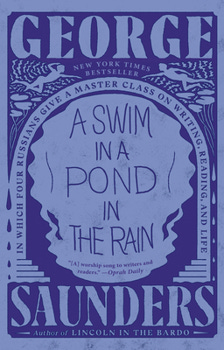
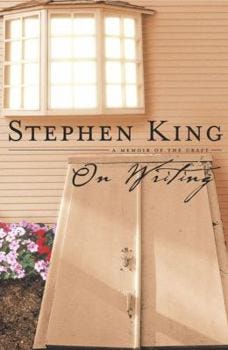
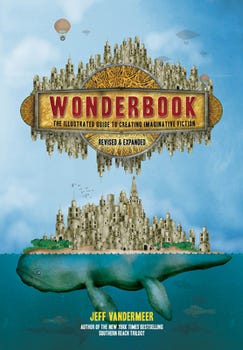
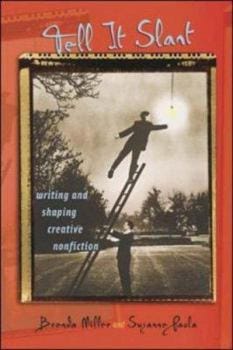


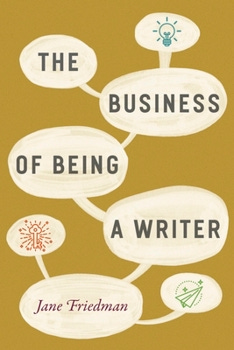
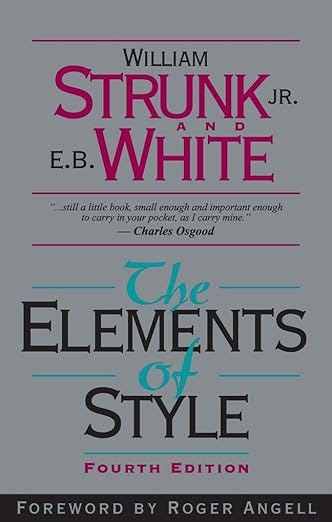

What a great list! The George Saunders book sounds fantastic.
Honored to be in such company! Thank you.